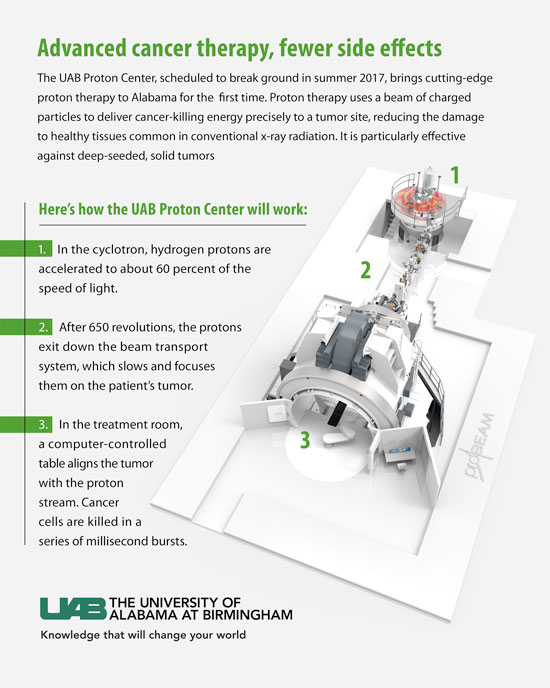The University of Alabama at Birmingham will partner with Proton International to bring proton therapy, one of the most technically advanced forms of cancer-killing radiation, to Alabama. Proton therapy delivers a more precise dose of radiation to a tumor and can avoid damage to healthy surrounding tissue better than conventional X-ray radiation.
“This is a significant step forward in cancer treatment for residents of Alabama and surrounding areas,” said Will Ferniany, Ph.D., CEO of the UAB Health System. “Proton therapy is an extremely advanced cancer-fighting radiation technology. Coupled with the skill, experience and resources of the UAB Comprehensive Cancer Center, the UAB Proton Therapy Center will be a life-changing resource for thousands of cancer patients throughout our region.”
 For more on proton therapy at UAB, click here. Click to enlarge.Proton International, one of the world’s leading developers of proton radiation facilities, will build the UAB Proton Center on the current site of parking lot 55, at 20th Street and Fifth Avenue. UAB physicians and staff will operate the center.
For more on proton therapy at UAB, click here. Click to enlarge.Proton International, one of the world’s leading developers of proton radiation facilities, will build the UAB Proton Center on the current site of parking lot 55, at 20th Street and Fifth Avenue. UAB physicians and staff will operate the center.
“Proton therapy will allow us to treat deep-seeded cancers and minimize the radiation dose delivered to surrounding normal structures,” said James A. Bonner, M.D., the Merle M. Salter Endowed Professor, Chairman of the UAB School of Medicine Department of Radiation Oncology and president of the University of Alabama Health Services Foundation. “This will be the first proton therapy center in Alabama, and we are excited to offer this cutting-edge approach for patients and families in Birmingham, across Alabama and beyond.”
There are 25 active proton therapy centers in the United States, most affiliated with major cancer centers. The roughly $50 million project has been approved by an administrative law judge appointed by the Alabama State Health Planning and Development Agency. Groundbreaking is expected in the summer of 2017, and construction and testing will take about two years before the building is clinically operational.
“Proton therapy is already having a tremendous impact on the health of people around the world,” said Chris Chandler, CEO of Proton International. “Experts conservatively estimate that about 250,000 cancer patients in the United States alone could benefit from proton therapy. We are excited to partner with UAB and put this outstanding tool into the hands of the best oncologists in Alabama.”
Proton therapy uses an aimed beam of protons directed at the tumor site. The beam is configured to deliver the majority of its energy precisely at the tumor location. Healthy tissue in front of the tumor receives a minimal amount of energy, and tissue behind the tumor receives very little. This reduces the damage to healthy tissue that is common in the use of conventional X-ray radiation and is the cause of most side effects.
“Recent advances in imaging have made proton therapy much more viable,” said John Fiveash, M.D., professor in the UAB Department of Radiation Oncology. “It uses sophisticated imaging to create a 3-D image of the tumor. It then delivers a focused beam of radiation, custom-sized and -shaped, so that it paints the tumor site while leaving surrounding tissue generally untouched, reducing collateral damage.”
Proton therapy is appropriate for many solid cancer tumors, including tumors of the brain and central nervous system, eye, gastrointestinal tract, head and neck, liver, lung, prostate, spine, and some breast tumors. It can be very efficacious for single-site tumors. In some cases, proton therapy may be useful in treating cancer that has metastasized, or spread into surrounding tissue, due to its focused dose advantages.
“Proton therapy is particularly beneficial for children, as they are especially vulnerable to damage from radiation,” said Alyssa Reddy, M.D., professor of hematology/oncology in the UAB Department of Pediatrics. “Conventional radiation can help cure a child’s cancer, but it carries an increased risk of damage to surrounding tissue. In children, tissue damage, particularly in still-developing organs such as the brain, can leave the child susceptible to myriad health issues that may not emerge for years. Proton therapy offers the opportunity to successfully treat pediatric tumors and minimize the risk for side effects later in life. This will improve the health and quality of life of pediatric cancer survivors, most of whom we expect to live long and productive lives.”
The UAB Proton Center will consist of a three-story building to house the proton therapy system, manufactured by Varian Medical Systems, a longtime partner with UAB in the delivery of radiation therapy. UAB will lease the property to Proton International, which will build and own the facility. Planning and pre-treatment will continue to be done at UAB’s Hazelrig-Salter Radiation Oncology Center. The medical staff, including radiation oncologists, cancer physicians, medical physicists, dosimetrists, radiation therapy technologists and nurses, will be exclusively from UAB.
UAB will also be involved in clinical research studies on the use of proton therapy, to discover the full utility of the therapy and produce best practice parameters on its use.
For more information on how proton therapy will work at the UAB Proton Therapy Center, click here.